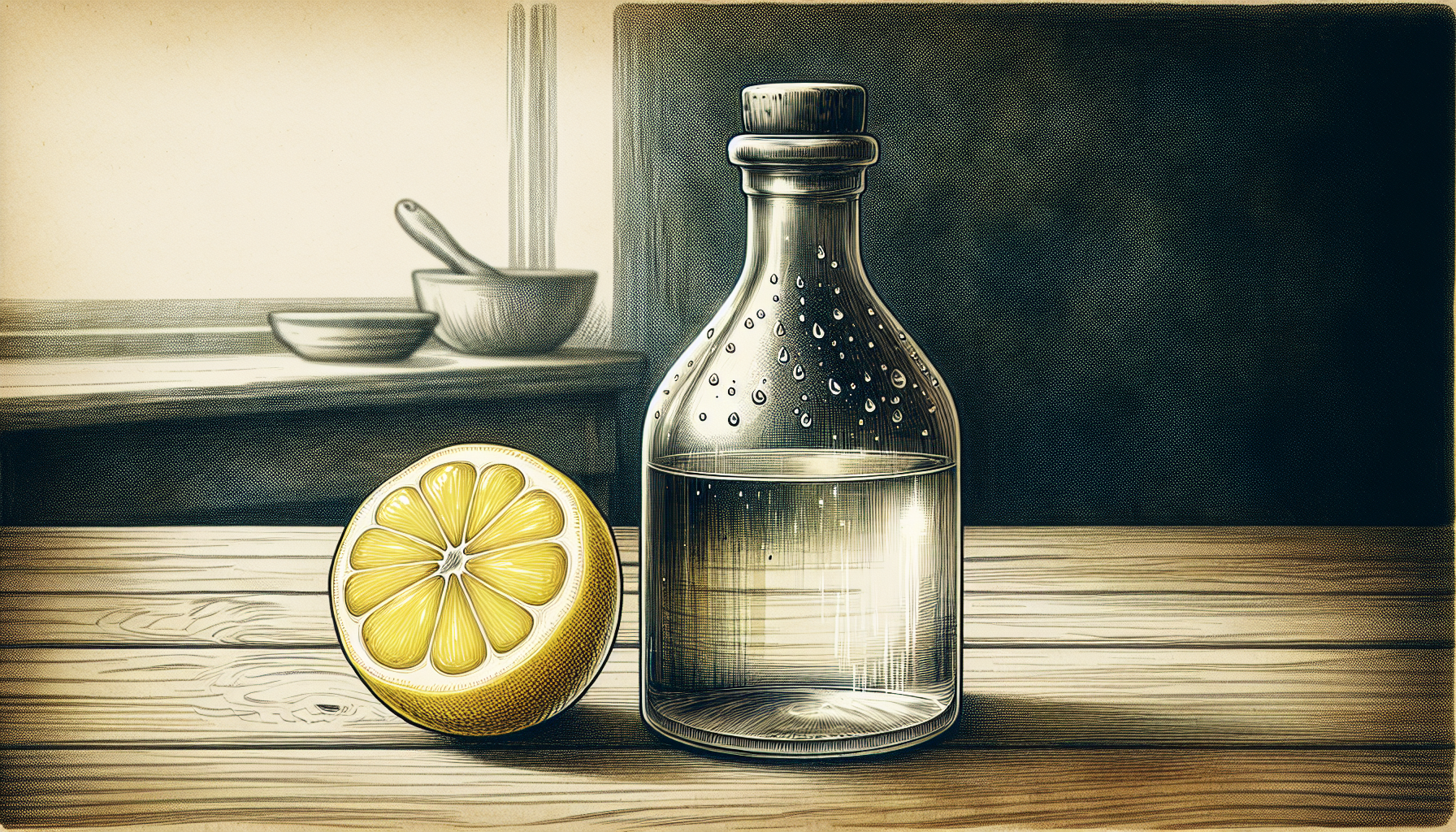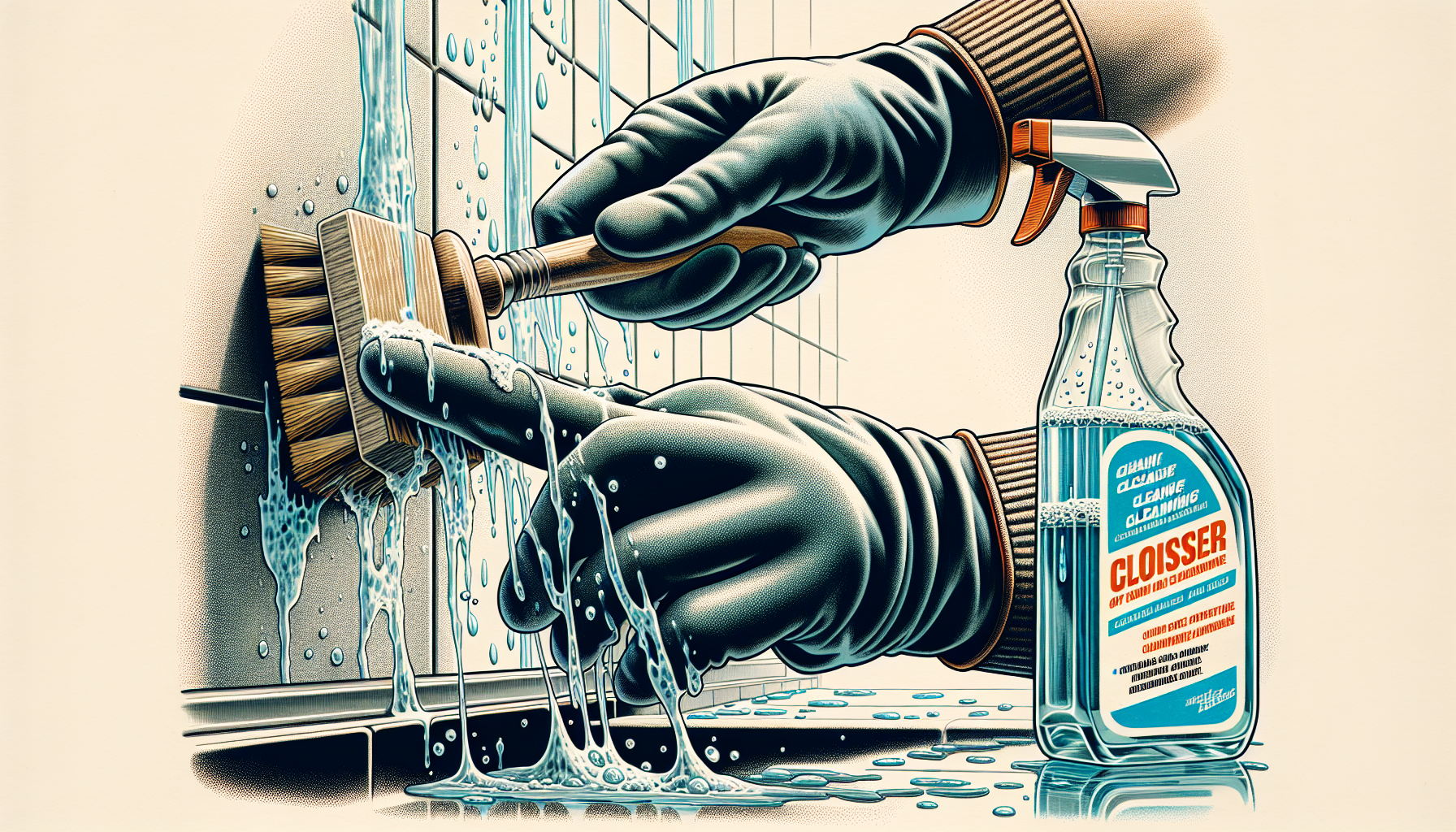If limescale in your shower has become a thorn in your side, you’re in the right place. This straightforward guide on how to remove limescale from the shower offers practical ways to remove limescale using everyday household items, ensuring your shower area regains its sparkle. Ready to tackle those unsightly white marks? Let’s get straight to the point with actionable advice, steering clear of fluff or unnecessary sales undertones.
Key Takeaways
- Limescale is mainly calcium carbonate left over when hard water evaporates, resulting in buildups that can clog shower heads and stain showers.
- Everyday household items like white vinegar, lemon juice, and baking soda are surprisingly effective and eco-friendly for tackling limescale.
- Consistent maintenance, using less mineral-rich water, and ventilating bathrooms can help prevent limescale buildup in the shower.
Understanding Limescale and Its Effects on Your Shower

Limescale is a pesky problem that many of us face, but what exactly is it? Limescale is primarily composed of calcium carbonate, which forms when hard water evaporates, leaving its mineral content behind. Hard water, rich in dissolved minerals like calcium and magnesium, is the main culprit behind limescale buildup on shower surfaces. This buildup causes cloudy shower glass, can clog your shower head, and leaves unsightly stains on tiles and faucets.
Limescale may not be hazardous to your health, but it’s undoubtedly a menace to your bathroom aesthetics. Those white, chalky deposits can make your shower glass look perpetually dirty, no matter how often you clean it. Furthermore, limescale can affect the performance of your showerhead, reducing water flow and making your showers less enjoyable.
Comprehending limescale’s composition and impact is an initial step in battling it effectively. Grasping how hard water contributes to the issue enhances your appreciation for routine upkeep and precise cleaning techniques, thereby maintaining the cleanliness and appearance of your shower.
The Battle Against Limescale: Tools and Ingredients You’ll Need
Before committing to eliminate limescale, equip yourself with appropriate tools and ingredients. For a practical at-home approach, you’ll need:
- white vinegar
- lemon juice
- baking soda
- a spray bottle
- rubber gloves
- paper towels
- a non-scratch scouring pad
These common household items are affordable and highly effective in tackling limescale buildup.
The acetic acid content in white vinegar distinguishes it as a potent natural limescale remover. Vinegar is cheaper and more sustainable than commercial products, offering a green alternative for your cleaning needs. For particularly stubborn limescale deposits, soaking the area with either lemon juice or white vinegar before scrubbing can enhance the cleaning process.
The Vinegar Solution: A Natural and Effective Limescale Remover

Regarding home remedies, vinegar is a tried-and-true solution for removing limescale. Distilled white vinegar can be used in various forms – diluted with water for light deposits or undiluted for tougher buildups. This versatile solution can be applied using a spray bottle for glass surfaces or soaked in a cloth for tiles and taps.
We’ll explore two efficient methods: the soak-scrub approach and the rinse-dry technique.
Soak and Scrub Method
The soak and scrub is a straightforward yet effective way to tackle limescale. Here’s how to do it:
- Start by soaking a cloth in white vinegar or a vinegar solution.
- Apply the vinegar-soaked cloth to the affected areas.
- You can secure the fabric with an elastic band and leave it for about an hour for glass surfaces.
- This prolonged contact time allows the acetic acid in the vinegar to break down the limescale deposits.
Once the soaking period is over, remove the cloth and put on your rubber gloves to protect your hands from potential irritation. Scrub the limescale off the surface using a damp cloth or a non-scratch scouring pad. This step might require some elbow grease, especially for more stubborn deposits, but the results are well worth the effort.
After scrubbing, you’ll observe a considerable decrease in limescale buildup. This approach is notably effective for glass door surfaces, such as shower glass doors and tiles, enhancing their clarity and cleanliness. Remember, the key is in the soak—the longer you let the vinegar work its magic, the easier the scrubbing will be.
Rinse and Dry Technique
Rinsing and drying are vital steps to validate your cleaning endeavors. After scrubbing away the limescale, thoroughly rinse the area with clean water. This helps remove any remaining vinegar solution and limescale particles, ensuring the surface is clean and free of any residue.
After rinsing, thoroughly dry the surface to inhibit the formation of new limescale deposits. Use a dry cloth or towel to wipe down the area, ensuring it is moisture-free. Polishing with a dry microfiber cloth can help achieve a streak-free finish for glass surfaces, leaving your shower gleaming and ready for use.
Citric Power: Using Lemon Juice to Combat Calcium Buildup
The citric acid in lemon juice makes it another natural and powerful limescale remover. Citric acid works similarly to acetic acid in vinegar by breaking down calcium carbonate, the primary component of limescale. Consider using lemon juice on your shower surfaces for a refreshing and effective clean.
To remove limescale from the shower glass, simply follow these steps:
- Cut a lemon in half.
- Rub the lemon directly onto the glass.
- Let the juice sit for about 10 minutes, allowing the citric acid to work magic.
- Rinse with warm water.
- Dry with a clean microfiber cloth.
This method removes limescale and leaves your shower smelling fresh and citrusy.
For taps and other fixtures, here’s a simple method to remove limescale:
- Soak a cloth in lemon juice.
- Wrap the cloth around the affected area and secure it with an elastic band.
- Let it sit for an hour.
- For particularly stubborn limescale, squeeze additional lemon juice directly onto the area and let it sit.
- Scrub the area and rinse.
This method can be very effective in removing limescale from your fixtures.
Baking Soda: The Gentle Abrasive for Tough Limescale Stains

Baking soda is a mild yet potent abrasive that helps remove stubborn limescale stains without damaging surfaces. Start by creating a paste with two tablespoons of baking soda and a small amount of water to form a thick consistency. You can mix the baking soda with warm white vinegar for enhanced cleaning action.
Apply the baking soda paste to the limescale stains, ensuring the affected areas are thoroughly covered. Allow the paste to sit for at least 30 minutes to penetrate and loosen the buildup. This waiting period is crucial as it allows the baking soda to break down the limescale deposits.
After the paste has had time to work, gently scrub the limescale away with a non-abrasive sponge or soft cloth. For glass surfaces, consider applying additional baking soda after a vinegar treatment and scrubbing with a damp rag to avoid scratches.
Once the scrubbing is complete, rinse the area with warm water to remove any remaining cleaning residue. A final rinse with distilled water can help ensure a streak-free finish on the glass.
Advanced Limescale Removal Techniques for Stubborn Areas

For obstinate limescale deposits that are hard to remove, employing advanced techniques may be required. One option is using concentrated acids, such as phosphoric or lactic acid, which are more potent than household vinegar or lemon juice. However, these acids can be corrosive and may damage metal pipes and fixtures, so they must be used cautiously.
When dealing with concentrated acids, it’s vital to safeguard your skin, respiratory system, and eyes. Always dilute the acid with water and neutralize it after use to ensure safety. For stubborn limescale on showerheads, an overnight soak in hot white vinegar can dissolve clogs, while vinegar-soaked cloths and a baking soda paste can effectively clean taps.
Shower doors with solid limescale granules or powder may require a stronger approach to clean the shower door. Here’s what you can do:
- Dissolve sodium hydroxide or lye in water.
- Apply the solution to the limescale on the shower doors.
- Take extreme care to avoid injury and damage to surfaces.
- Follow up with thorough rinsing and neutralization to ensure safety.
Regular Cleaning Routine: Prevention Is Better Than Cure
Prevention trumps cure, and maintaining a routine cleaning schedule can assist in warding off limescale. Here are some tips to help prevent limescale buildup in your shower:
- Use a squeegee or microfiber cloth to wipe down shower surfaces after each use to reduce water residue.
- Regularly clean your showerhead to remove any mineral deposits.
- Consider using a water softener or installing a water filter to reduce the amount of minerals in your water.
- Use a limescale remover or vinegar solution to clean any existing limescale buildup.
You can keep your shower clean and sparkling by following these tips and incorporating them into your cleaning routine.
Proper ventilation is also key in reducing bathroom humidity, contributing to limescale formation. Here are some tips to help reduce bathroom humidity and prevent limescale buildup:
- Ensure your bathroom is well-ventilated
- Consider using a dehumidifier if necessary
- Avoid hanging wet towels over glass shower doors
- Use a daily shower cleaner with limescale preventative properties to deter buildup and watermarks.
Complement your daily maintenance routine with a thorough bi-weekly shower cleaning. This involves using the methods and ingredients discussed earlier to keep limescale under control and your shower looking its best.
Softening the Blow: Considering a Water Softener

Installing a water softener can make a significant difference if you live in a hard water area. A water softener reduces the levels of calcium and magnesium in the water, effectively minimizing limescale buildup. This not only helps keep your shower clean but also enhances the cleaning efficiency of soap and detergents, reducing their use by up to 50%.
The benefits of softened water extend beyond the bathroom. It can lead to fewer dry skin and hair issues, less fading of clothes after washing, and improved performance of water heaters and washing machines. These appliances experience less wear and tear and deliver better results with less detergent.
A water softener is a worthwhile investment for anyone struggling with persistent limescale and hard water issues. It provides immediate benefits and contributes to the longevity and efficiency of your household appliances.
Summary
In summary, tackling limescale in your shower is all about using the right tools and methods, from natural solutions like vinegar and lemon juice to gentle abrasives like baking soda. Regular maintenance and considering a water softener can prevent future buildup and keep your shower sparkling clean. With these tips, you can say goodbye to limescale woes and enjoy a pristine bathroom.
Frequently Asked Questions
What is limescale, and why does it form in my shower?
Limescale is primarily composed of calcium carbonate, which forms in your shower due to the evaporation of hard water, leaving behind mineral deposits.
Can I use vinegar to remove limescale from all shower surfaces?
Yes, vinegar is effective for most shower surfaces, including glass doors, tiles, and taps. You can use it diluted or undiluted based on the severity of the buildup.
How often should I clean my shower to prevent limescale buildup?
To prevent limescale buildup, wipe down your shower after each use and deep clean it every two weeks. This will help keep limescale under control.
Are there any risks associated with using stronger acids for limescale removal?
Yes, using stronger acids for limescale removal can pose risks such as corrosion and damage to metal pipes and fixtures, so caution and proper dilution and neutralization are essential.
What are the benefits of installing a water softener?
Installing a water softener can reduce limescale buildup, improve soap efficiency, and enhance the performance of household appliances. It can also help reduce dry skin and hair issues.
